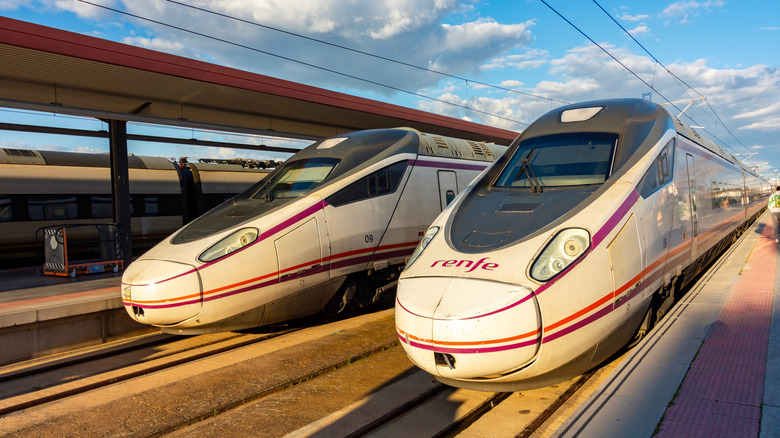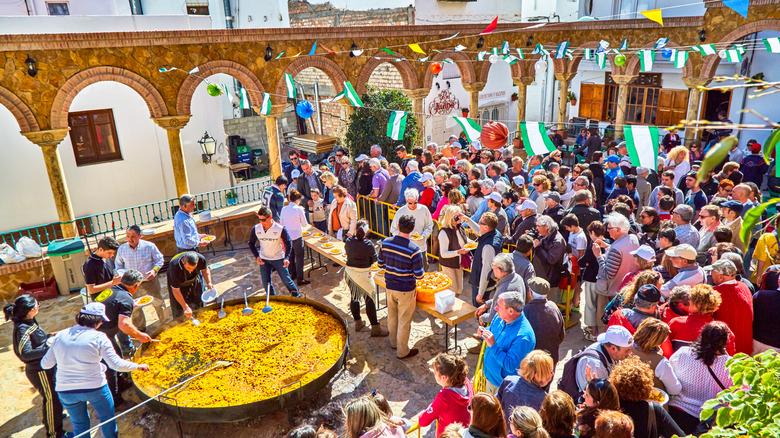The Country With Europe's Most High-Speed Rail Lines Is Also The Best Place To Live In 2025
There was a time when a train-loving backpacker's best bet for getting around Western Europe was by investing in an Interrail pass, which (all due respect to Interrail) was a huge amount of admin. You had to pre-select your countries and pre-book the fast trains. As adventurous as it felt to travel by train, it was a restrictive system to use. Jump 10 years ahead, and European rail travel is completely different. And one European country in particular is racing ahead of its neighbors. It's easier and faster to travel around Spain by rail than ever before, and the country has topped Europe's high-speed rail rankings with over 3,460 miles of high-speed tracks.
Spanish rail service Renfe has upped its game, launching high-speed lines from its sister company AVE — Alta Velocidad Española. AVE has managed to shave time off classic routes, rocketing between major cities like Madrid, Barcelona, Valencia, and Seville at speeds of 193 miles an hour. To add some healthy competition to the mix, high-speed operators Avant, Alvia, and the low-cost Avlo run on many of these routes as well. New train companies Iryo and Ouigo have also added affordable high-speed routes, ensuring there's a streamlined route to take you to just about every corner of the country in a few hours.
Collaboration between Renfe and French rail service TGV has also made Spain extremely accessible from France thanks to the Barcelona-Perpignan line. Now, high-speed carriages whizz through a tunnel under the Pyrenees, linking Spain to France in less than an hour and a half and costing around $30 when booked in advance. All of this adds to sunny Spain's appeal as one of the best places to live and retire abroad.
What is it that makes Spain so liveable?
The ease of affordable high-speed travel is making Spain a great country to explore. But other factors also make it an enviable destination to visit or to live. According to the global price comparison site Numbeo, which draws up a quality of life index twice annually, Spain has a very low cost of living compared to other European countries, only being beaten out by Portugal and some of the cheaper but no less delightful destinations in Eastern Europe, like Romania. Numbeo reports that Spain's residents also enjoy a high quality of life — undoubtedly because the country's devotion to the siesta and its perfectly sunny climate create a glorious work-life balance.
It's also a comparatively affordable Western European country when it comes to rent and housing prices. Expatica, a global platform for expats, reports that average monthly rent for a one-bedroom apartment in busy cities like Madrid and Barcelona is €1,293 to €1,370 (or $1,507.70 to $1,597.49 at the time of writing), but average rent in more affordable cities like Sevilla comes closer to $1,000 a month. Across the whole country, Spain is flying the flag for long-term renters and recently took on unlicensed Airbnb rentals in tourist-flooded cities and vacay hot spot islands like Menorca, ensuring locals aren't priced out. With delightfully affordable rent and a low cost of living in a country drenched with sunshine, it's hard to imagine a greater draw, but the cultural, historical, and extremely social aspects of life in Spain are all part of the appeal.
Exploring Spain as an expat resident
Spain is awash with gorgeous historic cities full of iconic art and ancient civilization, with Bilbao in the west, Toledo in the center, Seville in the south, and Valencia in the east. These culturally rich cities are stimulating for the brain without draining the budget. Local blogs cite vibrant celebrations like Seville's Semana Santa (meaning Holy Week), when costumed citizens walk down the streets in traditional religious parades, and Valencia's Fallas, a carnival of carpentry that sees huge satirical sculptures on floats marched through the streets.
Foodies also rejoice in this culinary nation. Tapas (small sharing plates, of Andalusian origin) and paella (a pan-stirred rice dish hailing from Valencia) might make the guidebook headlines, but lesser-known regional dishes are just as unmissable. Cocido madrileño, a chickpea stew from Madrid, and bacalao al pil pil, the Basque Country's cod fish in garlic sauce, are great reasons to get out and explore other parts of the country on the weekends.
The icing on this multi-tiered cake is experiencing the great Spanish outdoors, from trekking in the Pyrenees to swimming the shores of the Costa del Sol. The natural environment in this sunny southern stretch of Europe is as diverse as it is safe. And thanks to the country's increased investment in its high-speed train lines, it's easier and more affordable than ever to see all that Spain has to offer. It's no wonder that Spain is one of the best places to move to in 2025.


